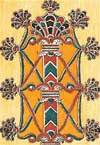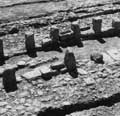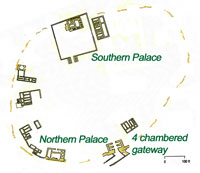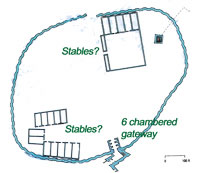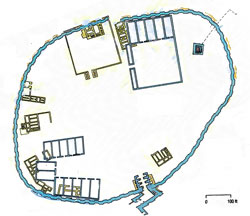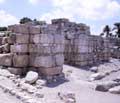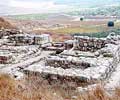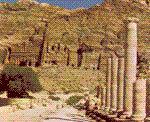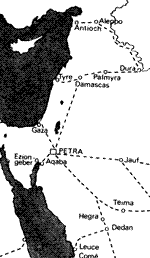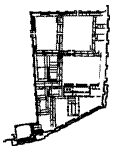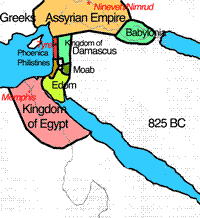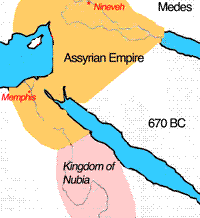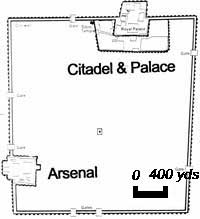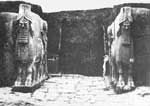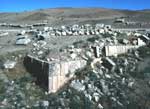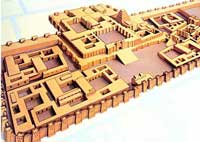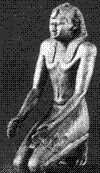David and the Kingdom of Damascus
The city of Damascus is at least 4000 years old. It is recorded as being conquered by Pharaoh Tutmosis in the 15th century BC and it became the capital of an Aramean kingdom from the 11th century BC. The Kingdom of Aram-Damascus resisted the Assyrians until late in the 9th century BC, and even came up against Pharaoh Shoshenk in the Jezreel Valley, conquering Israelite Dan along the way. Israelite refugees, displaced by the Arameans, resettled in the hill-country.
David, "son of Jesse the Bethlehemite," is a "curiously elusive figure" (Oxford Companion to the Bible). In turns shepherd, giant killer, court musician, poet, warlord and king, nothing and no one outside the Bible notes his existence.
If an original 'Dawid' inspired the legendary king, he was an inconsequential bandit chieftain in the Judaean hills, nothing more. Possibly the only element of truth in the biblical story is the episode of David as renegade and outlaw leader, living from theft.
In contrast to its heroics and intrigues of "King David", the Bible avoids mentioning Aram's 9th century conquest of much of Israel:
"Around 835 and 800 BC the kingdom of Aram-Damascus controlled the upper Jordan valley and significant areas in northeastern Israel – and devastated major Israelite administrative centres in the fertile Jezreel valley as well."(Finkelstein, Silberman, p202)
Dan, Hazor, Jezreel and Megiddo were among the cities destroyed.
Where Did They Get Their Ideas From? | 
Arab kingdom of Hazael
| 'David': Based on the Kings of Damascus?"Damascus reached its zenith during the reign of Hazael ... Transjordanian regions were overrun ... Hazael was able to cross Israelite territory to progress down the coastal plain to take Gath in Philistia ... In fact, Hazael appears to have established an empire or sphere of influence not unlike that ascribed to David."B.S.J. Isserlin (The Israelites, p86)King Hazael of Aram-Damascus (844-803) enjoyed a 40 year reign – just like that ascribed to the biblical 'David' and 'Solomon'! | 
Tel Dan Inscription
"The author was not
Hazael – it was his son, Bar Hadad ... The inscription has nothing to do with Jehu's coup and assassinations."– George Athas (University of Sidney – archaeologist and Christian!) | Tel Dan Inscription of the Aramean King Hazael?Three fragments of a 13-line Aramaic inscription discovered by archaeologists of the Nelson Glueck School of Biblical Archaeology in 1993/4 purportedly refer to the "House of David." One interpretation is that stele records King Hazael's 842 BC killing of "Jehoram, son of Ahab, king of Israel, and Ahaziah, son of Jehoram, king of the House of David. I set their towns to ruin, their land to desolation." The inscription appears to confirm that a chieftain called David was not pure invention yet even so, it contradicts the biblical story that it was Jehu who assassinated the tribal leaders in Jezreel."And Jehu drew a bow with his full strength, and smote Jehoram between his arms, and the arrow went out at his heart, and he sunk down in his chariot ... But when Ahaziah the king of Judah saw this, he fled by the way of the garden house. And Jehu followed after him, and said, Smite him also in the chariot." – 2 Kings 9:24,27But this interpretation of the fragments has been challenged, both by a realignment of the 3 fragments and a corrected rendering of the word "BYTDWD" – not "House of David" but a place-name meaning "House of Praise". |
|
Empire?
The fable of King David's "empire building" actually gets scant coverage in the Holy Book.
Episode 1. Civil War!
Having killed a giant and married into the royal family with a gift of foreskins, David falls foul of his father-in-law Saul and becomes a mercenary for the hated Philistines. They give him the town of Ziklag (from where he massacres Amalekite nomads of Sinai). But when Saul & Co get trashed by Philistines at Mount Gilboa, Saul's son Ish-Baal (inauspicious name,that!) is proclaimed king, somewhere east of the river Jordan.
David, now resident at Hebron, is also proclaimed king. Hostile co-existence, laced with a variety of arbitrary murders, ensues for over 2 years, at which point the assassination of Ish-Baal leaves the field free for David to rule "all Israel" (most of which, of course, is still in the hands of the Philistines).
Episode 2. The Capture of Jerusalem.
Our hero decides he needs a new residence in the hills – the town of Jebus. Oddly enough, this 'Jebusite' (Canaanite? Philistine?) enclave, in the heart of 'Hebrew territory', had never succumbed to Israelite conquest. Yet David has no problem taking the 'citadel' (how could he, with the LORD behind his every move). The blind and lame get short shrift from our conquering hero:
"And the king and his men went to Jerusalem unto the Jebusites ... which spake unto David, saying ... thou shalt not come in hither ... Nevertheless David took the stronghold of Zion ... And David said ... Whosoever getteth up to the gutter, and smiteth the Jebusites, and the lame and the blind that are hated of David's soul, he shall be chief and captain. Wherefore they said, The blind and the lame shall not come into the house. So David dwelt in the fort, and called it the city of David.
– 1 Samuel 5.6,9.
Episode 3. Conquering everywhere else – just like that!
The brevity (and brutality) with which the Holy Book records the conquest of the whole of Syrio/Palestine is breathtaking:
Defeat of the Philistines:
"And after this it came to pass that David smote the Philistines, and subdued them: and David took Methegammah out of the hand of the Philistines." – 2 Samuel 8.1.
Conquest of the North:
"David smote also Hadadezer, the son of Rehob, king of Zobah, as he went to recover his border at the river Euphrates ... David slew of the Syrians two and twenty thousand men. David put garrisons in Syria of Damascus: and the Syrians became servants to David." – 2 Samuel 8.3,6.
Genocide and conquest of the South:
"For it came to pass, when David was in Edom, and Joab the captain of the host was gone up to bury the slain, after he had smitten every male in Edom." – 2 Kings 11.15.
Mass Slaughter in the Transjordan:
"And he smote Moab, and measured them with a line, casting them down to the ground; even with two lines measured he to put to death, and with one full line to keep alive. And so the Moabites became David's servants, and brought gifts." – 2 Samuel 8.2.
"And it came to pass, after the year was expired, at the time when kings go forth to battle, that David sent Joab, and his servants with him, and all Israel; and they destroyed the children of Ammon, and besieged Rabbah." – 2 Samuel 11.1.
Not exactly Julius Caesar's The Gallic Wars!
As archaeology unequivocally testifies, in the 10th century BC in the valleys of Palestine Canaanite culture continued uninterrupted. Thankfully most of the biblical carnage that is the motif of "David's Empire Building" is a fanatic's fantasy.
Reality Check: The Omride Kingdom of Israel
An Israelite "empire" did eventually emerge – but in Samaria not Judah, and in the 9th, not the 10th century BC. Its founder was Omri, not David, a soldier/king who built himself the impressive palace-city of Samaria on the Syrian model. His dynasty – son Ahab, grandsons Ahaziah and Jehoram – raised a powerful army, built the cities of Megiddo, Gezer and Hazor, and ruled a successful state until defeated by Hazael of Aram-Damascus in 842 BC.
But the Omrides are not biblical heroes in the mould of David and Solomon. On the contrary, they are vilified and despised for that gravest of sins – worshipping the wrong god. In particular, Ahab and his wife Jezebel attract the worst opprobrium – mouthed in the curses of the wandering 'prophets' Elijah and Elisha (Jezebel is thrown from a window and dogs eat her corpse).
The isolated, poorer, smaller and more backward Israelite chiefdom of Judah, envious of and hostile towards its northern neighbour, would eventually use the fate of Samaria ('Israel') for theological purposes ('Look what happens when you disobey Yahweh').
Samaria succumbed to territorial erosion – first to Aram-Damascus, and then to Assyria. The capital city of Samaria finally fell in 720 BC.
Fanatics of the Yahweh cult fled south and began the process of inventing Judaism and writing a sacred history. In the fantasy, the village of Jerusalem becomes an imperial city; the 'House of David' an imperial dynasty.
First Evidence of an Israelite War LordIn 853 BC, at the hill top city of Qarqur in Syria, an alliance of petty Levantine kingdoms attempted to resist the advancing Assyrians. The 'Kurkh Stela' commemorates the Assyrian victory:"I razed, destroyed and burned ... 2,000 chariots, and 10,000 troops of Ahab, the Israelite ..." – Shalmaneser III
The Assyrians continued their advance in the next campaign season, defeating 'Jehu,' commemorated on the 'Black Obelisk'. | 
Kurkh Stela | 
| 841 BC -
The 'Black Obelisk' | 
Written in stone: Israel's 'Jehu, son of Omri' falls to the ground before Shalmaneser III | | 
Delicately carved ivory from Nimrud – testimony to Assyrian artistry
| | Shalmaneser's artifacts confirm the existence of a small Israelite kingdom – but NOT of the biblical story: 2 Kings 9,10 has it that Jehu was not Omri's son but an anointed assassin who had in fact murdered the 'house of Omri' on orders from Elisha! | "Woe to those who lay on beds of ivory."– Amos 6.4 |
|
Postscript: Biblical David's Deathbed Words to Solomon: KILL
| | Settling the score with Joab, faithful soldier of the Don:"Thou knowest also what Joab the son of Zeruiah did to me ...
Do therefore according to thy wisdom, and let not his hoar head go down to the grave in peace ...
So Benaiah the son of Jehoiada went up, and fell upon him, and slew him: and he was buried in his own house in the wilderness." (1 Kings 2.5,34)Settling the score with Shimei the Benjamite:"I sware to him by the LORD, saying, I will not put thee to death with the sword ...
hold him not guiltless: for thou art a wise man, and knowest what thou oughtest to do unto him;
but his hoar head bring thou down to the grave with blood.So the king commanded Benaiah the son of Jehoiada; which went out, and fell upon him, that he died. And the kingdom was established in the hand of Solomon." (1 Kings 2.8,46)Imperial Israel?Supposedly, an Israelite empire flourished in the 10th century BC, during a time of temporary weakness of both Assyria and Egypt. Yet the fabled empire of David and Solomon remains just that: a fable, unsupported by any evidence – and empires normally leave a great deal of evidence. The so-called 'United Monarchy' is found only in the Bible. The 'empire' has no monuments, no inscriptions and no artifacts. Neither David nor Solomon is as much as mentioned in the huge corpus of state records of either Egypt or Assyria. Concedes a 'pro-imperial Israel' historian: "Solomon ... in the eyes of Israelite historians, marked the apex of Israelite achievement. Curiously, no reference to him or his father David, or their empire in a non-Israelite source is known... "
(Isserlin, The Israelites, p72)
But of course there is nothing 'curious' about a non-existent 'empire' (stretching 'from the Euphrates to Egypt') leaving no evidence of its non-existence. Modern Israel is peppered with 'Solomon's monuments' – but not one of them has any genuine claim to the appellation. Solomon's Empire? | 
Hebrew hilltop settlements in the 10th century BC would not have been much larger than a soccer field, and archaeology has found not a brick of imperial grandeur. | 'Imperial' Jerusalem?Legendary kings David and Solomon supposedly had an imperial capital in Jerusalem. Yet extensive archaeology in the city reveals Jerusalem was a village in the 10th century BC. In contrast, Megiddo, 'part of the empire.' far to the north, had a palace!In reality, separate and distinctive chiefdoms developed in Samaria and Judah in the 9th century. They were never a 'united monarchy.' The north was larger, richer and more developed – and soon succumbed to the Assyrians.Judah, in reaction, produced its pious, biblical fraud, castigating the apostate kings of the 8th - 9th century northern kingdom of 'Israel' and elevated its own importance in an earlier, fantasised empire – ruled from an imperial capital of Jerusalem."... in Jerusalem nothing has as yet been brought to light which can be ascribed to Solomon with certainty."(Isserlin, p81)
| Where did they get their ideas from? | "Solomon ... began to build the house of the LORD ... And the whole house he overlaid with gold ... And within the oracle he made two cherubims of olive tree, each ten cubits high ... And he overlaid the cherubims with gold ... And he carved all the walls of the house round about with carved figures of cherubims and palm trees and open flowers." (1 Kings 6) |
|  '10 cubit winged cherub' – from Assyria! '10 cubit winged cherub' – from Assyria!
| 
Palm & floral motif– from Assyrian temple! | 
Was it this ... or this
... or this? | Lavish Temple?"Artist's impressions" of that fabulous Temple are commonplace, all based upon the biblical fantasy. Biblical descriptions of the building and its furniture are precise and vivid (1 Kings 6). But then they would be – they were a 'wish-list' of 7th/6th century priests. B elieve it or not, the 2 pillars had names – Jachin and Boaz.
| "The archaeological evidence in Jerusalem for the famous building projects of Solomon is nonexistent.19th and early 20th century excavations around the Temple Mount in Jerusalem failed to identify even a trace of Solomon's fabled Temple or palace complex."(Finkelstein, Silberman, p128) | 
7 years of slave labour? | "Jehoash Tablet" 
| "First confirmation" of Solomon's Jerusalem Temple. Only one problem – manufactured in Jerusalem in 2003!
|
|
Solomon: Emperor with No ClothesSolomon didn't need to conquer anything – the Empire was his inheritance from his father David. Solomon merely ruled in magnificence, effortlessly receiving and spending an imperial fortune, collecting girlfriends and dispensing wisdom. Really odd that no one seemed to have noticed. Could it all be a pious fraud, perhaps? Royal "Chariot city" of Megiddo? | "Solomon's Stables"? – but for the fact they're not Solomon's and not stables!Distinctive storerooms were so identified until a palace structure beneath them came to light. Then "stables" re-attributed to Ahab so that the palace could be identified as "Solomon's." In truth, the palaces date from 9th not 10th century BC and the city of the stables is even later – the 8th century BC.But were they stables? Nothing relating to horses, cavalry or chariots has ever come to light. "Horse troughs" had drainage holes and were possibly vats for preparing opium, a narcotic for the pain of childbirth and disease.Solomon is said to have had "a thousand and four hundred" chariots (1 Kings 1.26) – a prodigious army by ancient standards. Yet only five years after the fabled king's death, the same Bible says Pharaoh Shishak successfully invaded Judah and captured its fortified cities with little or no military resistance (2 Chronicles 12). |
| 
'Solomon's Stables' – actually 8th century storehouses of Assyrian vassal Jeroboam II. | "Solomon's Gates"? Wishful thinking – 9th century BC, not 10th. |
| | | | | Omri's 9th century BC Megiddo | | "Solomon's 10th century BC Megiddo"?? No kidding | | Reality: "Solomon's" Megiddo
built on top of Omri's! | 
| | 
| |  | |

Megiddo – Devastated by King Hazael of Aram-Damascus and 'deserted for almost half a century' (Finkelstein, 204) | In the 1950s, Yigael Yadin – Israeli Defence Chief of Staff turned archaeologist – decided that the ruins of Megiddo, Hazor and Gezer were the legendary 'Fortress Cities' of Solomon. "Our great guide was the Bible" he said. Thus he confirmed the Bible with the Bible.This was despite an absence of any find at the sites naming Solomon – but a cartouche naming Pharaoh Amenhotep III instead!Destruction of the sites was attributed to 'Yahweh's instrument' – the 8th century Assyrians. But the Arameans beat them to it, before themselves succumbing to the Assyrians in 811 BC. Jeroboam II (788 - 747 BC), an Assyrian client king of Israel, rebuilt Megiddo, Gezer and Hazor and presided over the last period of Israel's prosperity. His reign helped to colour the legend of 'Solomon', written in the 7th century. |
| 
Gezer
Hazor |
|
| Solomon – "Smarter than All" | Solomon the Builder?"Monumental structures once attributed to the building activities of Solomon in the cities of Megiddo, Gezer and Hazor have been shown over the years to date from various archaeological periods spanning centuries."– Rohl (A Test of Time, p34)Nabataea
Petra: Unlike the fabled kingdom of Solomon, evidence of the Edomites/ Nabataeans is not in doubt.Ancient trade routes
I. Browning (Petra, p14) | Shortly after their deliverance – variously dated between 1550 - 1200 BC – Yahweh’s chosen people are (apparently) given the ten rules to live by. Yet despite their inside track with God (and witnessing all manner of awful manifestations of his power) their kings are certainly no observers of his rules. In the sacred history, even less devout, mediocre kings follow the fabled "Golden Age of Solomon," an era and an empire for which there is not the slightest trace of evidence. King Solomon and Unnamed Pharaoh No. 6 – his father-in-law!This Pharaoh, it seems, led an expedition into Palestine and made a wedding gift of a ruined city full of corpses: "Pharaoh the king of Egypt himself had come up and then captured Gezer and burned it with fire, and the Canaanites dwelling in the city he had killed. So he gave it as a parting gift to his daughter, the wife of Solomon." (1 Kings 9:16)
The girl was obviously resigned to an open marriage – she shared Solomon with 700 wives and 300 concubines. (1 Kings 11.1) Still, he was a smart fellow. Apparently his wisdom "excelled all the wisdom of Egypt." (1 Kings 4.30) No kidding. "Hadad the Edomite" and Unnamed Pharaoh No. 7 – who shelters Solomon's enemy Now here's a curiosity. Hadad receives from this friendly pharaoh a house, bread, land, and marriage into the royal household! Yet it is only the inconsequential pharaonic wife 'Tahpenes' who is named (1 Kings 11:19, 20).
Edom – Occasional refuge and long-term foe of HebrewsPioneers of copper working, the Edomite kingdom between the Dead Sea and the Red Sea was often at the receiving end of Israelite aggression (well that's what the Bible says). Apparently, the long-suffering Edomites sheltered David from Saul – before being massacred by him! Notwithstanding that "every male in Edom had been smitten" (1 Kings 11:15) the Edomites migrated into southern Palestine. 'Edomea' became 'Idumea' and was conquered and Judaised during time of the 'Maccabee' John Hyrcanus. The Nabataeans moved into the region vacated by the Edomites from the 6th century BC onward. Their city of Petra controlled the lucrative trade routes going north to Damascus and west to Gaza (by-passing any Israelite enclaves). Bands of Israelites probably raided the caravans from time to time – hence the mutual hostility. |
|
|
Rise of Assyria 1000 - 600 BC
An Israelite Empire? Don't Blink!
Sargon of Akkad was the first king to assert control outside of his city-state in 2371 BC. In 1813 BC Shamshi-Adad united the cities of Ashur, Nineveh, Arbel and Nimrud into a cohesive unit – Assyria. Several Assyrian empires rose and fell over the following 1200 years. The last period of imperial conquest began with Shalmaneser III in the 9th century BC. Assyria's main rival, of course, was Egypt.
Shalmaneser & Nimrud (Kalah)The Assyrian king Shalmaneser III (858-824) ruled his empire from the mighty city of Nimrud on the Tigris. The 37 metre thick walls, 8 km in length, enclosed 3.6 sq km. (900 acres) of palaces, temples and parks and dwellings for an estimated 63,000 inhabitants. The city was quadrilateral in shape, with a Ziggurat in the south-west and “Fort Shalmaneser” in the south-east. After the Assyrian intrusion into Syria/Palestine of 841 BC King Jehu of Israel was forced to pay tribute. The Aramean Kingdom of Damascus under King Hazael maintained a protracted resistance. | 
Shalmaneser's fortified
palace at Nimrud |  | 4 warrior/kings in particular built the Assyrian Empire: Shalmaneser III (859-824), Tiglath Pilesar III (743-726), Esarhaddon (680-669) and Assurbanipal (668-627). The secret of their success appears to have been: iron-working; the war chariot; and an efficient civil service collecting tax.Hebrew settlements to the south west of Damascus (tiny 'Kingdoms of Judah & Israel') were vassals of the Damascenes, who, for a time, held the Assyrians at bay.Phoenician trading fleets out of Tyre established an 'escape route' to a maritime empire in the western Mediterranean (the future 'Carthaginian' empire)All the small kingdoms of Palestine were conquered about 725 BC and Egypt itself a century later. |
|  | "This is what archaeologists have learned from their excavations in the Land of Israel ... the united monarchy of David and Solomon, which is described by the Bible as a regional power, was at most a small tribal kingdom. " (Ha'aretz Magazine, October 1999)
|
|
|
|
Meanwhile, in the Mountains ...In the clash of the Egyptian empire to the south west and the Assyrian/ Babylonian empires to the north east, the Israelites were at best mercenaries and conscripts. The intrusion of Shalmaneser III in 841 BC – recorded on Assyrian monuments – is not mentioned in the sacred texts, but the subsequent fall of the northern kingdom of Israel in 722 BC (to Sargon II, though erroneously credited to Shalmaneser [V] in 2 Kings 17.6) is noted. Supposedly‘10 tribesof the Jewish race’ were lost through conquest. "Therefore the LORD was very angry with Israel, and removed them out of his sight: there was none left but the tribe of Judah only." – 2 Kings 17.18. The traumatic loss of most of the Israelite 'nation' was to be the catalyst for a profound religious revolution: Yahweh priests, fleeing south to the tiny enclave of Judah, stiffened Jewish resistance by dreaming up the notion of a former 'great empire' which, under priestly direction, would rise again. In 701 BC the Assyrians returned, devastated Judah and occupied the province. The Jewish king Hezekiah (715 - 687 BC) was besieged in Jerusalem but plague compelled the Assyrians to move on. Judah – reduced to little more than the environs of Jerusalem – maintained a precarious existence for another century by costly tributes to the Assyrian king. Putting a brave face on events, Hezekiah's priests heralded the reprieve of Jerusalem as a victory for Yahweh! Isaiah would have us believe that overnight the 'angel of the LORD' smote the Assyrians, leaving a 185,000 to "arise early in the morning, and behold, they were all dead corpses." (Isaiah, 37.36). (To give a comparison, Hadrian's legions wiped Judaea off the map early in the 2nd century AD with about 40,000 troops.) Over the next half century "Judaism" emerged – a religious response to the Assyrian assault and the total loss of the northern kingdom. Sargon'sDur Sharrukin (Khorsabad)Although his predecessor Shalmaneser IV gets the credit (2 Kings 17), the Assyrian Sargon II (722 - 705) made biblical headlines in his inaugural year by a campaign in the west which, among other triumphs, included the conquest of the northern kingdom of Israel and its capital Samaria. Assyrians were resettled in the province.Yahweh priests fleeing south to Judah stiffened Jewish resistance by dreaming up the notion of a former 'great empire' which, under priestly direction, would rise again. A triumphant Sargon returned to the Assyrian heartland and built himself a new capital – Khorsabad. | 
Archaeology has revealed the plan of Sargon II's capital. It covered about 300 hectares. | 
'Solomon's' Jerusalem – 1/20th size of Assyrian Khorsabad | 
| Evidence at Khorsabad Massive human-headed, winged bulls represented the might of Assyria |  | Extant ruins of Khorsabad Letters to & from the royal architect Tab-shar-Ashur, written on clay tablets, reveal that cedar from Lebanon was used extensively . |
|  | Reconstruction. The city Khorsabad flourished after Sargon's death in 705 BC, though his son Sennacherib (705 - 681 BC) moved the capital to Nineveh. |
|
|
|
|---|
Meanwhile, in the Mountains (Part 2)Hezekiah was followed by his son Manasseh (686 - 642 BC) and grandson Amon (641 -640) – both castigated in the sacred texts for ignoring priestly dictates – but then a hero of Judaism emerged: the 8-year-old Josiah. During his 'guided' reign (639 - 609 BC) 'reform' elevated the priests of Yahweh and eliminated the competition. Sacred 'high places' in the countryside were destroyed and rival priests were murdered. Communion with God now became a monopoly of the Jerusalem Yahwehists. Conveniently, a second statement of 'The Law of Moses' –Deuteronomy– was 'found' in the Temple to give the divine seal of approval. To graphically illustrate what was possible in a dynastic theocracy the fable of the 'Yahweh-guided, fabulous kingdom' – of Saul, David and Solomon – set 300 years earlier, was now fleshed out in painstaking detail (Samuel, Kings, Chronicles). The fable of 'Imperial Israel' – long on court intrigue and adulteries but short on how the empire was won – reflects incidental detail from the empires the Israelites themselves faced as an enemy – the Assyrians and Babylonians of the 9th - 6th centuries! The pious fantasy was further embellished in in the 6th and 5th centuries, in the aftermath of Babylonian conquest of Judah and the "captivity" (597-539 BC). Sennacherib'sNineveh | | Sennacherib (705-681 BC) moved the Assyrian capital to Nineveh, a vast walled city of 7.5 sq km. The Temple of Ishtar alone was half a kilometre long! Fitments to the Royal Palace included 3 kilometres of carvings, over 100 massive bulls and sphinxes and vast quantities of Lebanese cedar, carried over 500 miles, and decorated with gold and silver.In 701 BC Sennacherib devastated Judah, the minor 'southern' kingdom allied with Egypt and Phoenicia. The Assyrians occupied 46 walled towns and compelled the Jewish king Hezekiah to shut himself up in Jerusalem "like a bird in a cage." Plague compelled Sennacherib to abandon the siege and Judah – reduced to little more than the environs of Jerusalem – maintained a precarious existence for another century by costly tributes to the Assyrian king.Putting a brave face on events, Hezekiah's priests heralded the reprieve as a victory for Yahweh! | The fantasy of Solomon's Palace:"The throne had six steps ... and two lions stood beside the stays. And twelve lions stood there on the one side and on the other upon the six steps ... And all king Solomon's drinking vessels were of gold, and all the vessels of the house of the forest of Lebanon were of pure gold; none were of silver: it was nothing accounted of in the days of Solomon." (1 Kings 10) The fantasy of vast tribute – and 666!"And when the queen of Sheba heard of the fame of Solomon ... she gave the king an hundred and twenty talents of gold, and of spices very great store, and precious stones ... And the navy also of Hiram, that brought gold from Ophir ... Now the weight of gold that came to Solomon in one year was six hundred threescore and six talents of gold ... So king Solomon exceeded all the kings of the earth for riches and for wisdom." (1 Kings 10) | Assyrian inscriptions list the king's wars, booty and buildings – just like the 'Book of Kings' ! |
|
Egypt's Last Bid for Empire: Pharaoh Nekau IIHerodotus records that Nekau succeeded his father Psamtik I in 610 BC as pharaoh and assigns him a reign of sixteen years. Monuments and artifacts attest to his existence. It seems that the declining 7th century Assyrian conquerors of Egypt installed a vassal called Nekau (circa 655 BC) and this 'governor' in the delta was the grandfather of the future pharaoh Nekau II. Nekau seems to have been an enterprising king: Herodotus writes that he attempted to complete the canal connecting the Red Sea with the Nile, and when he abandoned that project he sent a Phoenician expedition to circumnavigate Africa, which was successfully accomplished in 3 years. In real history, Pharaoh Nekau II saw an opportunity to revive an Egyptian empire in Syria by assisting his Assyrian ally after the fall of Nineveh to the Babylonians in 612 BC. Archaeologists, aware that Josiah was in no position to challenge the mighty Egyptian army, suspect that Nekau merely summoned Josiah to some sort of royal parley and had him killed for unknown reasons. With Josiah dead (609 BC) Nekau continued north but was himself defeated at Carchemish (605 BC). The biblical Necho has a slightly different career ... | At last! – a genuine biblical pharaoh: 'Necho' | 
Nekau – Pharaoh, 6th century BC | 2 Kings and 2 Chronicles tell of Pharaoh Necho.In the biblical fantasy, for no very good reason Josiah, King of Judah, gets in the way of Nekau's army, moving north. The odd behaviour of the Judaean king includes 'disguise' and choosing an unfavourable battleground. But Nekau is on 'God's business' and Josiah is being silly. The point, of course, is theological: Don't you dare go against the Lord!"Necho king of Egypt came up to fight against Carchemish by Euphrates: and Josiah went out against him ... and hearkened not unto the words of Necho from the mouth of God, and came to fight in the valley of Megiddo." (2 Chr. 35.20,22) In this silly story, the polytheistic Egyptian king has become the mouthpiece of the Hebrew "God" who has sent him on a mission!"But he sent ambassadors to him, saying, What have I to do with thee, thou king of Judah? I come not against thee this day, but against the house wherewith I have war:for God commanded me to make haste: forbear thee from meddling with God, who is with me,that he destroy thee not."
(2 Chr. 35.21) In a carefully woven weave, real history is mixed into a sacred legend. In any event, the (mostly!) righteous king is killed and Judah slides into oblivion.As to Nekau giving 'Josiah' a knock-out blow on his way to the Euphrates, Herodotus says nothing – but then Herodotus had never heard of the Jews anyway! |
|
BabylonOn his return from the northern front – according to the Bible – Nekau installed a puppet king ('Jehoiakim') in Jerusalem but poor Jehoiakim also "does evil in the sight of the LORD" and gets his own divine comeuppance – this time from Nebuchadnezzar of Babylon (601 BC). Judah is conquered in 586 BC and its people carried into exile. In the biblical story, Babylon's governor is murdered and fearing retribution, Jews (that is, the ones who didn't get carried into exile! ) – flee to Egypt. This includes 'Jeremiah,' a phantom 7th century prophet created by the 3rd/4th century BC scribe who wrote the entire Josiah saga (2 Chronicles, Jeremiah). At this stage the Jews are under Persian rule, Egypt is weak but nominally independent. The Jewish priestly scribe hammers home his point about 'bad kings' indulging in 'foreign practices.' Reiterating the central message of Deuteronomy (the "fifth book of Moses") – supposedly 'found' during Josiah's rebuilding of the Temple, it looks forward to happier times, when pious kings are controlled by priests and 'fear God':
"Thou shalt in any wise set him king over thee, whom the LORD thy God shall choose ... When he sitteth upon the throne of his kingdom, that he shall write him a copy of this law in a book out of that which is before the priests the Levites: And it shall be with him, and he shall read therein all the days of his life: that he may learn to fear the LORD his God ..." – Deuteronomy 17.14,20.
|
|


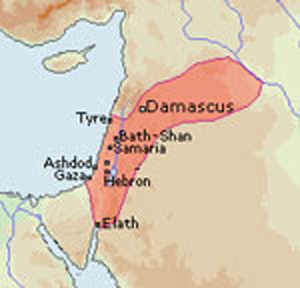
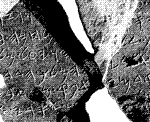
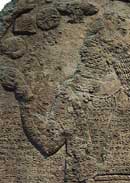

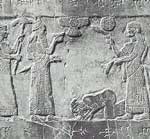
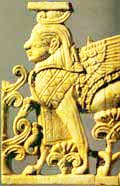
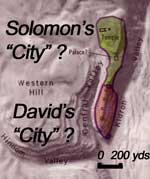
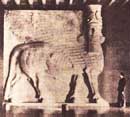 '10 cubit winged cherub' – from Assyria!
'10 cubit winged cherub' – from Assyria!